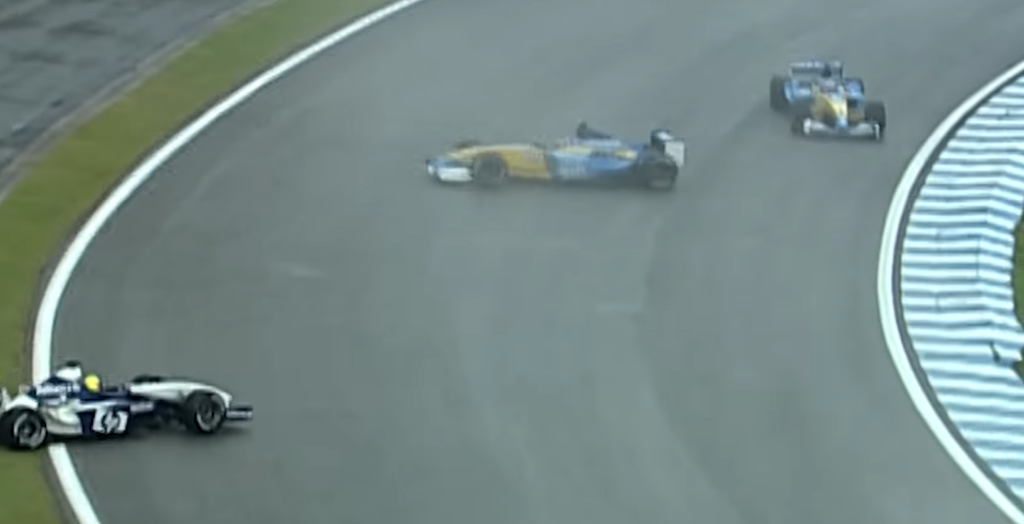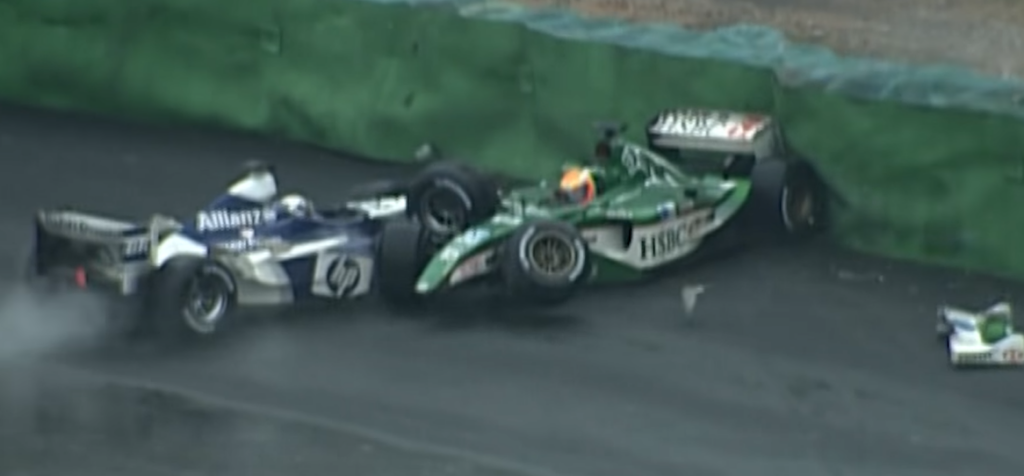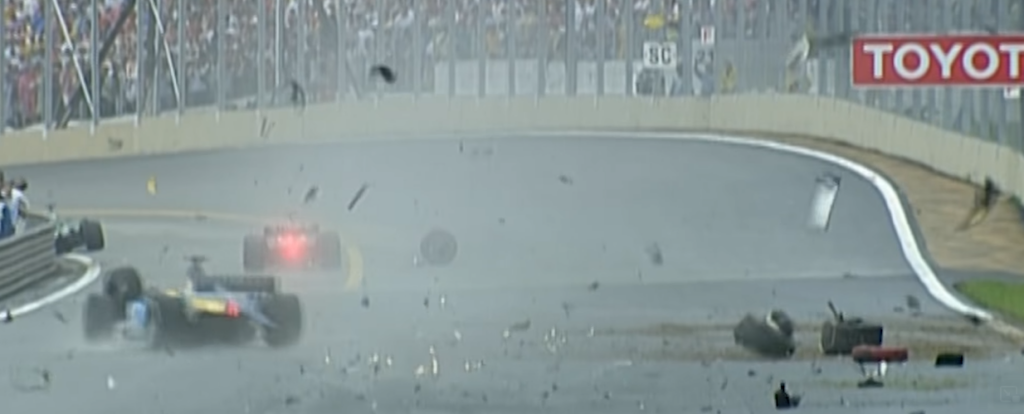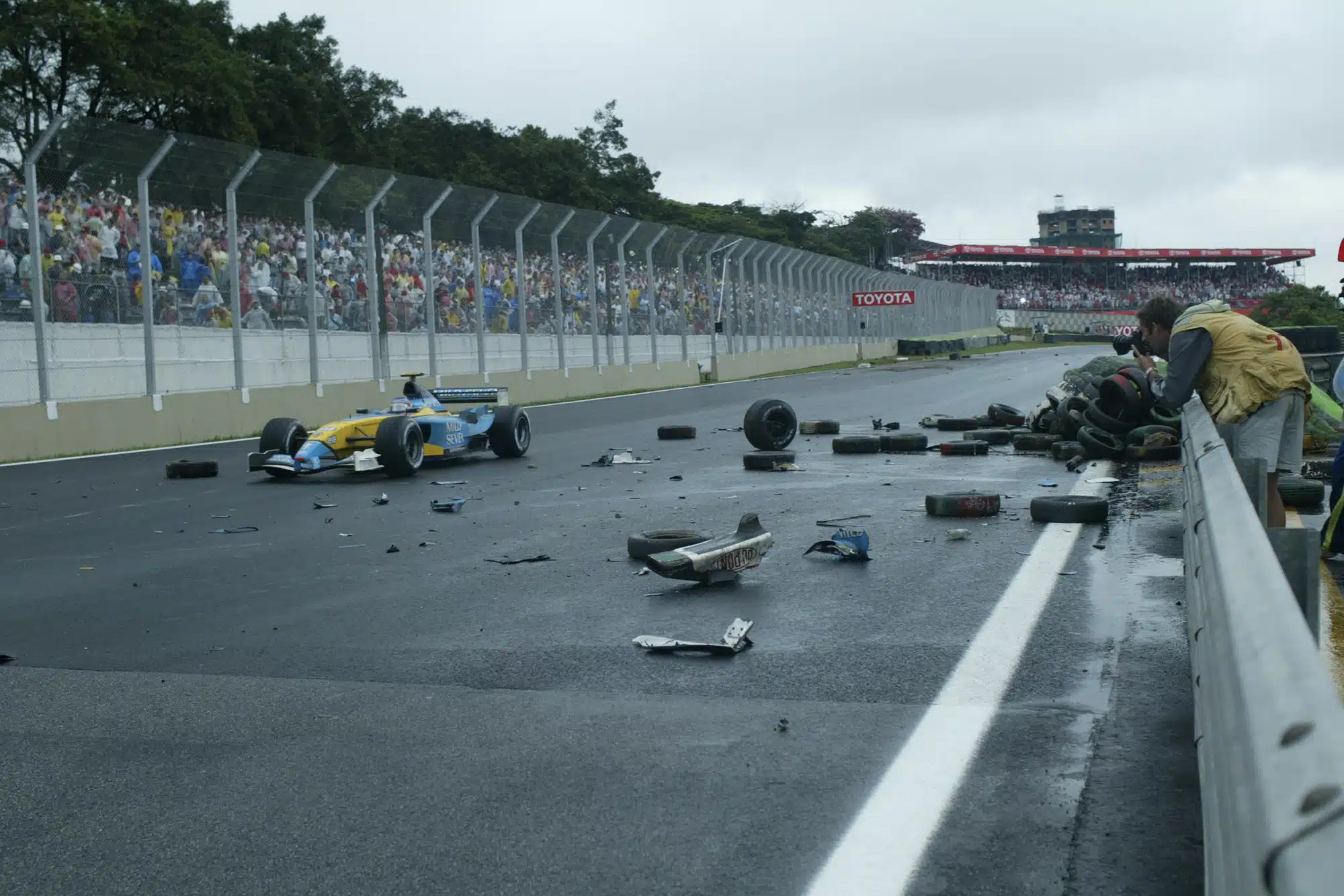The 2003 Brazilian Grand Prix was a race that will forever be etched in the annals of Formula 1 history.
With four safety car appearances, a treacherous turn three, a near-death experience, and a race victor who saw his car burst into flames, this race had more twists and turns than the track itself.
In the third round of the 2003 season, Formula 1 was undergoing a significant transformation. New rules introduced by FIA president Max Mosley brought about the desired effect, with Ferrari failing to win any of the first three races. The scene was set for one of the most spectacular F1 races of all time at Interlagos.
The ever-changing weather during qualifying resulted in a shuffled grid, with seasoned front-runners like Michael Schumacher and Rubens Barrichello finding themselves further back than anticipated.
Amidst the Brazilian crowd’s cheers, Barrichello’s Ferrari eventually clinched pole position, flanked by the McLaren of Kimi Räikkönen and David Coulthard, and the Jaguar of Mark Webber.
Table of Contents
- 1 The Transformed F1 Landscape in 2003
- 2 Interlagos – A Challenging Circuit Amidst Unpredictable Weather
- 3 The Chaotic Start – Safety Cars and Strategic Pit Stops
- 4 The Battle for the Lead – Barrichello vs. Räikkönen vs. Montoya
- 5 The Treacherous Turn Three – Aquaplaning and Crashes
- 6 The Final Laps – Barrichello’s Heartbreak and Räikkönen’s Struggle
- 7 The Unbelievable Finish – Fisichella’s Unlikely Victory and the Controversial Aftermath
The Transformed F1 Landscape in 2003
The 2003 season marked a significant shift in the F1 landscape. The sport was recovering from a lackluster 2002 Championship dominated by Ferrari and Michael Schumacher.
The new rules introduced by Mosley aimed to level the playing field and bring about closer racing.
Rising talents like Kimi Räikkönen and Fernando Alonso of Renault were beginning to shine, supported by a formidable Williams BMW car.
The F1 manufacturer era was gaining momentum, with powerhouses like BMW, Ferrari, Mercedes, and Toyota injecting unprecedented investments into the sport.
The Brazilian Grand Prix at Interlagos would be the backdrop for one of the most spectacular F1 races of all time, showcasing the transformed F1 landscape and the unpredictable nature of the sport.

Interlagos – A Challenging Circuit Amidst Unpredictable Weather
Interlagos, located in São Paulo, Brazil, is a circuit known for its challenging layout and unpredictable weather conditions. The circuit’s undulating terrain and high-speed corners provide a stern test for drivers and their machines.
Following a mid-morning downpour on race day, the track conditions were challenging, to say the least. Interlagos looked closer to the Amazon River than an actual racetrack.
The new rule in the 2003 season mandated teams to stick to a single type of wet tire for an entire weekend, be it intermediates or full wets, adding to the challenge.
The Chaotic Start – Safety Cars and Strategic Pit Stops

The race start was delayed by 15 minutes due to a fierce storm sweeping through the circuit. Once the cars emerged onto the track, it was behind the safety car, and so it would be for eight laps as everyone tried to make the track somewhat safe to drive on.
As the race drew closer to going green, all eyes were on the dramatic battle for the top positions. Once the safety car pulled in, Barrichello attempted a strategic start, holding back his acceleration until just before the starting line.
However, this tactic backfired, and Coulthard punished him for that down into turn one, causing him to lose the lead to Coulthard’s McLaren.
Räikkönen’s McLaren zoomed past Barrichello into turn one and he repeated the maneuver shortly after, snatching the lead from Coulthard and leaving the latter vulnerable.
Montoya, driving for Williams BMW, showed his class by swiftly warming his Michelin tires and surging from seventh to claim second position from Coulthard around the outside of turn three on lap 11 out of the 54-lap race.
The Battle for the Lead – Barrichello vs. Räikkönen vs. Montoya
The battle for the lead was intense, with Barrichello, Räikkönen, and Montoya showcasing their skills and determination. Barrichello, battling a misfire that eventually cleared, slipped as low as sixth but swiftly made his way back up the ranks, overtaking Webber who had been pressuring Montoya.
Webber, carrying a relatively modest fuel load for a two-stop race, was really putting himself about against the best in his first appearance at the front of the grid. This phase of the race remained relatively calm compared to the events that were yet to unfold.
Despite a scuffle between Trulli and Ralf Schumacher at turn three, both emerged unscathed. However, the calm was short-lived as the first major incident of the race involving Panis and Firman prompted the return of the safety car.
The Treacherous Turn Three – Aquaplaning and Crashes
Turn three at Interlagos proved to be a treacherous corner, with several drivers falling victim to aquaplaning :
- Montoya spun at the turn three left-hander on lap 25,
- 3 Laps later, Michael Schumacher, holding a solid third place, veered off at the same perilous spot, prompting the safety car’s third appearance of the day.
This turn of events elevated Coulthard to the lead, closely trailed by Barrichello, Ralf Schumacher, and Webber.
As the race roared back to life, Coulthard clung tenaciously to his lead, but he found himself unable to shake off Barrichello’s relentless pursuit.
The Michelin intermediates on Coulthard’s car had a slightly deeper cut and additional lateral grooves, providing better grip in wetter conditions and a faster warm-up.
However, as sections of the track began to dry, the Bridgestone tires proved to be the better choice, playing into Barrichello’s favor.
Räikkönen pitted under the safety car, dropping him to seventh and elevating Coulthard to the lead, closely trailed by Barrichello, Ralf Schumacher, and Webber.
As the race roared back to life, Coulthard clung tenaciously to his lead, but he found himself unable to shake off Barrichello’s relentless pursuit.
The Final Laps – Barrichello’s Heartbreak and Räikkönen’s Struggle

As the laps ticked on, the race charged forward under green flag conditions until lap 34, when the safety car was once again deployed, triggered by Jenson Button’s heavy crash at turn three.
With Webber taking advantage of the situation to pit, the race reset for the final sprint to the finish.
Coulthard, Barrichello, and Ralf Schumacher were positioned for podium glory, with Räikkönen in fifth ahead of Alonso and Fisichella.
As the laps ticked on to number 37, Coulthard made a clean getaway to the final restart, and Räikkönen executed a superb pass on Alonso on the inside into turn four.
Räikkönen then showcased his prowess by overtaking Ralf Schumacher for third. Barrichello remained patient, knowing his opportunity would come with Coulthard struggling on his front Michelins and the Bridgestone tires gaining traction as much of the track was dry.
On lap 45, Coulthard overshot at turn one, allowing Barrichello to take the lead amidst the roar of the crowd.

The Unbelievable Finish – Fisichella’s Unlikely Victory and the Controversial Aftermath
In a shocking turn of events, Barrichello ran out of fuel despite the data suggesting he had enough to compete several more laps without a hitch.
This turn of events propelled Coulthard back into the lead, but he had to make a pit stop for fuel and fresh tires at the end of lap 52.
This strategic move positioned Räikkönen in the lead, but he grappled with his struggling Michelins and faced relentless pressure from Fisichella, who was charging him in the Bridgestone-equipped Jordan.
On lap 54, Räikkönen’s grip slipped at the Marulio left-hander, and Fisichella, against all odds, seized the golden opportunity to claim the lead.
However, the ending was anything but a fairy tale. On the same lap that Fisichella took the lead, Mark Webber in his Jaguar suffered a spectacular crash at the Arribas corner, scattering deadly debris across the road and causing a red flag.
With over three-quarters of the race completed, an official result was declared, but even this wasn’t straightforward.
Initially, it seemed Fisichella would be crowned the victor, and he jubilantly celebrated with his team in Parc Fermé. However, things wouldn’t stay that way.
A countback of two laps was undertaken to determine the final result, selecting lap 53 when Räikkönen was in the lead.
When the time came for the trophy presentation, Räikkönen stood on the top step of the podium, while a disappointed Fisichella settled for runner-up.
The saga continued even after the end of the race, with Jordan presenting evidence that Fisichella had actually started lap 56 when the race was halted.
After reconvening in Paris, the stewards concurred with Jordan’s claim, ultimately declaring Fisichella as the fairy tale victor on the Friday following the race.
It marked his long-awaited first win, but it would also be Jordan’s final triumph. In a fitting end to a race like this, the governing body redid the trophy ceremony, where Räikkönen awkwardly handed Fisichella the trophy before a practice session at the following round at Imola.
